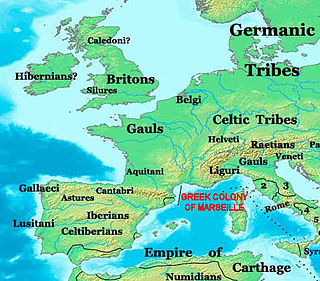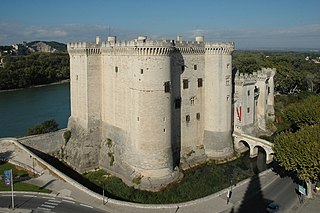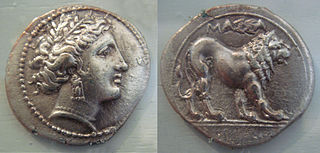Theopompus was an ancient Greek historian and rhetorician.

Empúries was an ancient city on the Mediterranean coast of Catalonia, Spain. The city Ἐμπόριον was founded in 575 BC by Greek colonists from Phocaea. After the invasion of Gaul from Iberia by Hannibal the Carthaginian general in 218 BC, the city was occupied by the Romans. In the Early Middle Ages, the city's exposed coastal position left it open to marauders and it was abandoned.

Monaco City is the southcentral ward in the Principality of Monaco. Located on a headland that extends into the Mediterranean Sea, it is nicknamed The Rock. The name "Monaco City" is misleading: it is not itself a city, but a historical and statistical district. It holds most of the country's political and judicial institutions: the Prince's Palace, the town hall, the government, the National Council, the Municipal Council, the courts and a prison.

Port Hercules is the only deep-water port in Monaco. The port has been in use since ancient times. The modern port was completed in 1926, and underwent substantial improvements in the 1970s. It covers almost 40 acres (160,000 m2), enough to provide anchorage for up to 700 vessels. The port is located in the La Condamine district. Harbour pilots are required for all vessels longer than 30 metres. The depth of water in the harbour ranges from seven metres for standard berths and up to 40 metres for the outer piers and cruise ship docks.

The naval Battle of Alalia took place between 540 BC and 535 BC off the coast of Corsica between Greeks and the allied Etruscans and Carthaginians. A Greek force of 60 Phocaean ships defeated a Punic-Etruscan fleet of 120 ships while emigrating to the western Mediterranean and the nearby colony of Alalia.
The Salyes or Salluvii were an ancient Celto-Ligurian people dwelling between the Durance river and the Greek colony of Massalia during the Iron Age. Although earlier writers called them 'Ligurian', Strabo used the denomination 'Celto-ligurian' in the early 1st century AD. A Celtic influence is noticeable in their religion, which centred on the cult of the tête coupée, as well as in the names of their towns and leaders. During the 2nd century BC, the Salyes were most likely at the head of a political and military confederation that united both Gallic and Ligurian tribes.
The Vocontii were a Gallic people dwelling on the western foothills of the Alps during the Iron Age and the Roman period.
Bellovesus is a legendary Gallic chief of the Bituriges, said to have lived ca. 600 BC. According to a legend recounted by Livy, the king Ambigatus sent his sister's sons Bellovesus and Segovesus in search of new lands to settle because of overpopulation in their homeland. While Segovesus headed towards the Hercynian Forest, Bellovesus is said to have led the Gallic invasion of the Po Valley during the legendary reign of the fifth king of Rome, Tarquinius Priscus, where he allegedly conquered the Etruscans and founded the city of Mediolanum (Milan).

Mainake, Menace was an ancient Greek settlement lying in the southeast of Spain, according to the Greek geographer and historian Strabo (3,4,2) and Pausanias of Damascus. Pausanias adds that it was a colony of the Greek city of Massalia. Maria Eugenia Aubet locates it at the site of modern Málaga. The first colonial settlement in the area, dating from the late 8th century BC, was made by seafaring Phoenicians from Tyre, Lebanon, on an islet in the estuary of the Guadalhorce River at Cerro del Villar.
The architecture of Provence includes a rich collection of monuments from the Roman era, Cistercian monasteries from the Romanesque period, medieval castles and fortifications, as well as numerous hilltop villages and fine churches. Provence was a very poor region after the 18th century, but in the 20th century it had an economic revival and became the site of one of the most influential buildings of the 20th century, the Unité d'Habitation of the architect Le Corbusier in Marseille.

The Greek community in France numbers around between 35,000 - 50,000 people. They are located all around the country but the main communities are located in Paris, Marseille and Grenoble.

The Greeks in pre-Roman Gaul have a significant history of settlement, trade, cultural influence, and armed conflict in the Celtic territory of Gaul, starting from the 6th century BC during the Greek Archaic period. Following the founding of the major trading post of Massalia in 600 BC by the Phocaeans at present day Marseille, Massalians had a complex history of interaction with peoples of the region. Large Greek colonies also existed west of the Rhône, particularly at Agde and Béziers, the latter of which both predates, and was larger than, the Marseille colony.

The Segusiavī were a Gallic tribe dwelling around the modern city of Feurs (Auvergne-Rhône-Alpes) during the Iron Age and the Roman period.
The Segobrigii or Segobriges were a Celto-Ligurian people dwelling in the hinterland of the Greek colony of Massalia during the Iron Age.

The historic French province of Provence, located in the southeast corner of France between the Alps, the Mediterranean, the river Rhône and the upper reaches of the river Durance, was inhabited by Ligures beginning in Neolithic times; by the Celtic since about 900 BC, and by Greek colonists since about 600 BC. It was conquered by Rome at the end of the 2nd century BC. From 879 until 1486, it was a semi-independent state ruled by the Counts of Provence. In 1481, the title passed to Louis XI of France. In 1486 Provence was legally incorporated into France. Provence has been a part of France for over 400 years, but the people of Provence, particularly in the interior, have kept a cultural identity that persists to this day.

Marseille, France was originally founded circa 600 BC as the Greek colony of Massalia and populated by Greeks from Phocaea. It became the preeminent Greek polis in the Hellenized region of southern Gaul. The city-state allied with the Roman Republic against Carthage during the Second Punic War, retaining its independence and commercial empire throughout the western Mediterranean even as Rome expanded into Western Europe and North Africa. However, the city lost its independence following the Roman Siege of Massilia in 49 BC, during Caesar's Civil War, in which Massalia sided with the exiled faction at war with Julius Caesar.

Massalia was an ancient Greek colony (apoikia) on the Mediterranean coast, east of the Rhône. Settled by the Ionians from Phocaea in 600 BC, this apoikia grew up rapidly, and its population set up many outposts for trading in modern-day Spain, Corsica and Liguria. Massalia persisted as an independent colony until the Roman campaign in Gaul in the 1st Century BC. The ruins of Massalia still exist in the contemporary city of Marseille, which is considered the oldest city of France and one of Europe's oldest continuously inhabited settlements.
The Protiadae were a prominent Massaliote family. The family probably claimed descent from the Phocaean Greek Prō̃tis (Πρῶτις), a legendary figure said to be the son of Euxenus, a Phocaean founder of Massalia, in one account and to have himself founded the city in another. Aristotle reported that the family was still present in the area in his time.
Aristarche is a Greek mythological figure said by Strabo to have been an Ephesian woman of rank who went with the Phocaean colonists to Massalia, where she became a priestess of Artemis in the newly built temple.
The Phocæans is an epic poem in blank verse by Walter Savage Landor, likely composed around 1795, first published in 1802. The subject matter of the poem was suggested by Landor's readings of several passages in the writings of the Latin historian Justin, relating how the Phocaeans were displaced from Ionia in western Anatolia by the invasion of Harpagus and his men, serving under Cyrus the Great. In the poem, the Phocaeans seek aid from the king of Tartessus. A minstrel named Hymneus relates the history of the Tartessians as a moral example, before Protis, the leader of the Phocæans, relates at length their defiance of the Persian king. Incomplete and fragmentary, the poem was to be completed with the settlement of the Phocæans in Gaul, and their foundation of the city of Massalia or Marseilles, with the presence of Celtic influences.


![Fondation de Marseille by Francois Gilbert [fr] (1816-1891). Palais de la Bourse, Marseille. Marseille Bourse interieur sculpture voussure 2.jpg](http://upload.wikimedia.org/wikipedia/commons/thumb/5/5a/Marseille_Bourse_int%C3%A9rieur_sculpture_voussure_2.jpg/220px-Marseille_Bourse_int%C3%A9rieur_sculpture_voussure_2.jpg)










